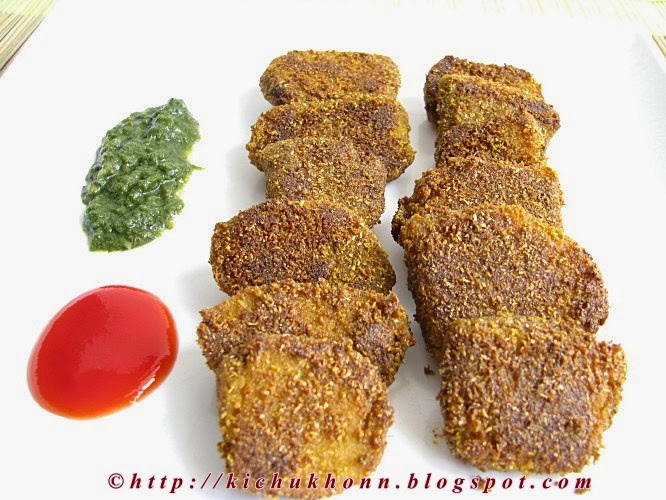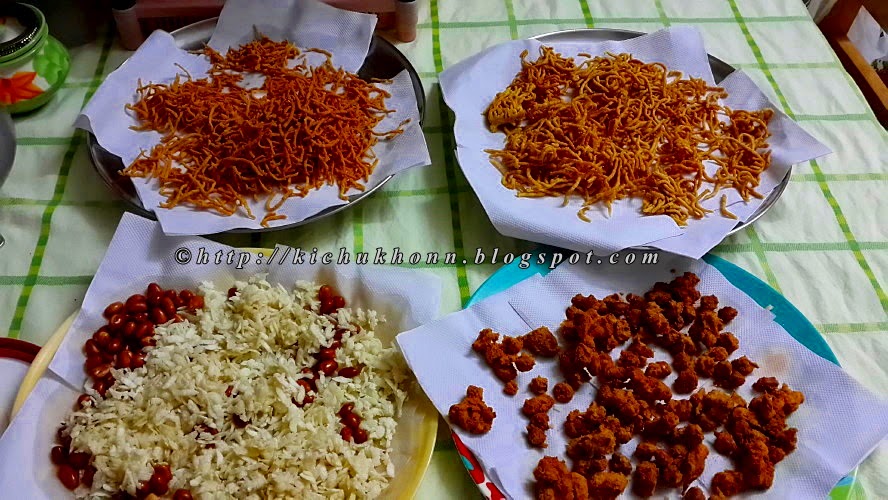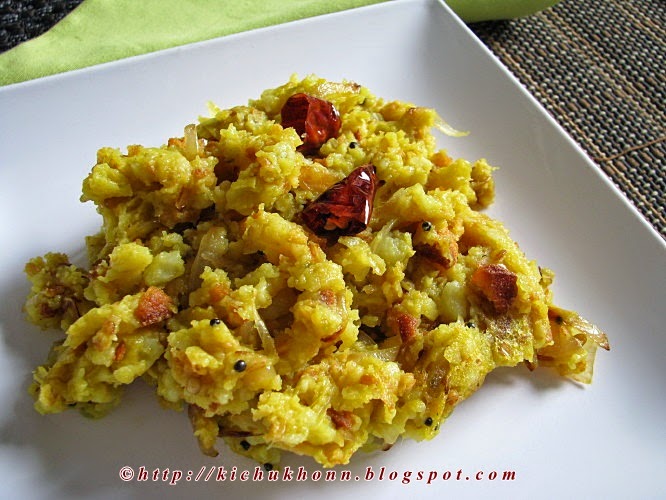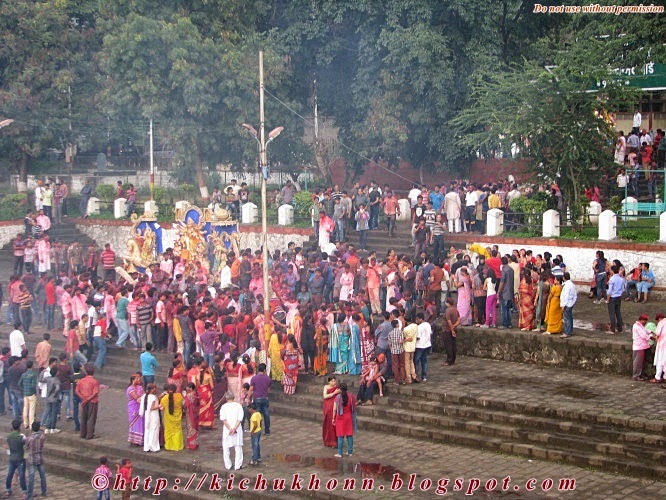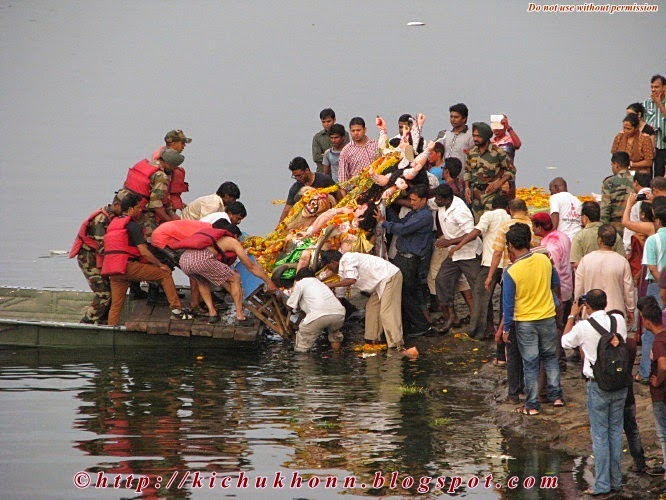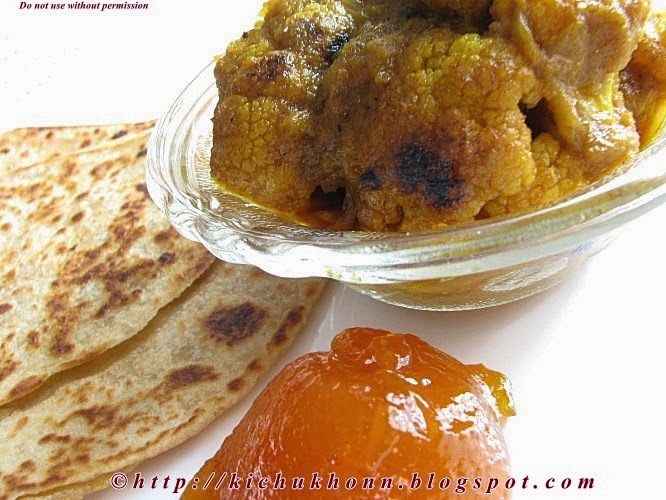It was just on the last post that I was complaining about the dull weather.
Someone up there was listening ... or so I'd like to believe.
For, the weather changed immediately the next day and the morning was chilly and cold.
The evenings already have that dry, wintery smell in the air. Coupled with the smoke of wood fire coming from the make shift chulhas the new workers for a construction have set up, winter seems to be already here. At least on my balcony, right now; these evenings.
And also when I went downstairs to go to the fishwala for my weekly stash of fish, I couldnt help but stop awhile and draw a deep breath. High up on the building, while I do get the best of sunlight and wind, I do not get the smell of the trees and the damp smell of water and earth mixed with the fresh smell of trodden grass.
To this mix the smell of woodfire and smoke and chilly air of an evening; I though I was in heaven.
No ... I thought I was home.
Back home, I used to love these smells that now have settled in my memories and help me describe home. So when I think of home, I do see the two huge ponds on the left and the right of the entrance with the walkway going through them. But I also think of the fishy smell of the water from the ponds, coupled with crisp, clean air and the smell of grass. Mixed with them the smell of the mango trees. And the smoke drifting from the chulhas that the helps used to cook.
And so many other smells mixed together ... I cannot put a finger on each one.
But it is the winter mornings that I love best. The smell of, that is.
That clean smell in the crisp and biting cold air. Coupled with the smell of toasted bread and eggs poached in butter, sunny side up with a dash of salt and pepper. With that would be the wonderful smell of hot milk. The breakfast that we had most days, sitting out in the lawn under the sun ,in huge cane chairs; with Dadu. We would surely be holding a notebook and a pencil each ... the brood was supposed to be doing their studies in the sun ... but studying was the last thing we would be doing at the time. Not when Dadu was with us. :-)
Those are the best memories of my childhood winters.
Later I would grow up and associate winter with many other foods, but winter mornings will always
stay in my memory as a mix of biting cold, fuzzy warmth, breakfasts smelling like heaven and a lot of laughter.
It is difficult to change tracks right away ; I feel like writing on and on. But I have to get to today's recipe. And get this post over with.
The madness of Diwali has passed by. And I have just got hold of a very good book.
Need to get back to it as soon as possible. :-)
This recipe is again belongs to the Mother in law. As most Rajasthani recipes on my blog do.
Growing up, I had never eaten Arbi or Kochu, as it called in Bengali.
I am not counting if it has been smuggled into me in the form of a ghonto (a mixed vegetables dish) or a chanchra ( again a mixed vegetable dish ... that often had fish head too).
As far as I remember, I had never even seen a kochu or arbi till I grew up and got married.
B had very enthusiastically got a lot once when he had gone green grocery shopping.
And had excitedly announced it. I failed to return the enthusiasm with proper intensity as I was too busy studying a piece of vegetable that looked pitifully deformed to me.
Worse, every piece was different from the other. I was worried he had got something abnormal.
I mean there is so much of playing around with genes etc. of stuff going on.
Not to give up, B did what he does best. Call Mom.
She, on her part, very happily rattled off at least three or four dishes ... after all it was her son's favourite vegetable. And I , on my part, was still coming to terms with hing. And now this deformed vegetable. I was in a daze.
But then I went ahead and made that first dish that I had named as Creamy Arbi. And had the audacity to post it, in all innocence.
Btw ... it is a hot favourite with the man and his family .. heaven's grace. :-)
Today, I do cook Arbi in many avatars. Ok ... just five or six kinds ... but that is many to me.
And if you ask me, I'll say the truth.
I do not eat Arbi. Or Kochu. Still.
Ma in law has this way of dumping all the masalas together and adding to a dish.
Bengalis would add a dash of water to that and koshao or bhuno it.
Not she.
If you see my Kundru ki sabzi and Gawar ki sabzi, you will know of this way.
So that is how I fry the boiled Arbi too ... dunk it in a mix of masalas and fry till crisp.
Now, when I get Arbi, I divide the lot into two; I make this, along with a sabzi.
I usually make it for dinner as B likes to much on these with some salad and chutney. But I finally made these during the day to be able to click photographs and make a post.
You may call this a Kochur cutlet in Bengali, if you want to. But the flavours will still stay Rajasthani.
To get the Bengali flavours, you can make a mix of the Bhaja moshla + rice flour ( chaler guro ) + amchur powder + salt + red chilli powder ( lonka guro ) + salt + a pinch of kalo jeere / kalonji / nigella seeds .... and fry it in mustard oil.
So here goes the recipe for this quick snack or starter.
Need :
Arbi / Colocassia / Kochu - amount as per your wish
Haldi / Turmeric powder
Red chilli powder
Dhania powder
Rice flour - 1 tbsp
Besan - just a little ... around a ¼ tsp
Amchur powder - to taste
Salt - to taste
Cooking oil to lightly fry - around 1 tbsp
How to :
Soak the arbi in enough water. Scrub it clean.
Boil in a pressure cooker with a little salt for two whistles on low flame.
Remove lid and drain immediately.
Spread on a plate and let it dry well.
( I keep it overnight in the fridge, uncovered. And suggest you do the same, if possible.
This dries the arbi completely and there is no slime on it and makes it easier to peel.
If not overnight, at least for half an hour. )
Peel it.
Cut into small flat pieces. This will be difficult due to its uneven shapes.
You can halve them too and press with your hands to flatten them.
Make a mix of all the dry ingredients.

Dunk in the arbi pieces and press gently for the masalas to coat the pieces properly.
Heat oil in a shallow, open faced pan.
Arrange the arbi pieces and fry till golden brown on one side.
Turn them over and fry the other side too.
Serve hot with chutneys or ketchup and salad, as a snack.
Can be enjoyed on the side with a main meal too.
This is one recipe that has helped me to convert. Yes, I do enjoy the kochu in this version.
Enjoy!!
Other low oil crispies on Kichu Khon -
Aloo Narkel Tikki
Crispy Fried Kumro / Pumpkin
Crispy Fried Parwal / Potol / Pointed gourd
Someone up there was listening ... or so I'd like to believe.
For, the weather changed immediately the next day and the morning was chilly and cold.
The evenings already have that dry, wintery smell in the air. Coupled with the smoke of wood fire coming from the make shift chulhas the new workers for a construction have set up, winter seems to be already here. At least on my balcony, right now; these evenings.
And also when I went downstairs to go to the fishwala for my weekly stash of fish, I couldnt help but stop awhile and draw a deep breath. High up on the building, while I do get the best of sunlight and wind, I do not get the smell of the trees and the damp smell of water and earth mixed with the fresh smell of trodden grass.
To this mix the smell of woodfire and smoke and chilly air of an evening; I though I was in heaven.
No ... I thought I was home.
Back home, I used to love these smells that now have settled in my memories and help me describe home. So when I think of home, I do see the two huge ponds on the left and the right of the entrance with the walkway going through them. But I also think of the fishy smell of the water from the ponds, coupled with crisp, clean air and the smell of grass. Mixed with them the smell of the mango trees. And the smoke drifting from the chulhas that the helps used to cook.
And so many other smells mixed together ... I cannot put a finger on each one.
But it is the winter mornings that I love best. The smell of, that is.
That clean smell in the crisp and biting cold air. Coupled with the smell of toasted bread and eggs poached in butter, sunny side up with a dash of salt and pepper. With that would be the wonderful smell of hot milk. The breakfast that we had most days, sitting out in the lawn under the sun ,in huge cane chairs; with Dadu. We would surely be holding a notebook and a pencil each ... the brood was supposed to be doing their studies in the sun ... but studying was the last thing we would be doing at the time. Not when Dadu was with us. :-)
Those are the best memories of my childhood winters.
Later I would grow up and associate winter with many other foods, but winter mornings will always
stay in my memory as a mix of biting cold, fuzzy warmth, breakfasts smelling like heaven and a lot of laughter.
It is difficult to change tracks right away ; I feel like writing on and on. But I have to get to today's recipe. And get this post over with.
The madness of Diwali has passed by. And I have just got hold of a very good book.
Need to get back to it as soon as possible. :-)
This recipe is again belongs to the Mother in law. As most Rajasthani recipes on my blog do.
Growing up, I had never eaten Arbi or Kochu, as it called in Bengali.
I am not counting if it has been smuggled into me in the form of a ghonto (a mixed vegetables dish) or a chanchra ( again a mixed vegetable dish ... that often had fish head too).
As far as I remember, I had never even seen a kochu or arbi till I grew up and got married.
B had very enthusiastically got a lot once when he had gone green grocery shopping.
And had excitedly announced it. I failed to return the enthusiasm with proper intensity as I was too busy studying a piece of vegetable that looked pitifully deformed to me.
Worse, every piece was different from the other. I was worried he had got something abnormal.
I mean there is so much of playing around with genes etc. of stuff going on.
Not to give up, B did what he does best. Call Mom.
She, on her part, very happily rattled off at least three or four dishes ... after all it was her son's favourite vegetable. And I , on my part, was still coming to terms with hing. And now this deformed vegetable. I was in a daze.
But then I went ahead and made that first dish that I had named as Creamy Arbi. And had the audacity to post it, in all innocence.
Btw ... it is a hot favourite with the man and his family .. heaven's grace. :-)
Today, I do cook Arbi in many avatars. Ok ... just five or six kinds ... but that is many to me.
And if you ask me, I'll say the truth.
I do not eat Arbi. Or Kochu. Still.
Ma in law has this way of dumping all the masalas together and adding to a dish.
Bengalis would add a dash of water to that and koshao or bhuno it.
Not she.
If you see my Kundru ki sabzi and Gawar ki sabzi, you will know of this way.
So that is how I fry the boiled Arbi too ... dunk it in a mix of masalas and fry till crisp.
Now, when I get Arbi, I divide the lot into two; I make this, along with a sabzi.
I usually make it for dinner as B likes to much on these with some salad and chutney. But I finally made these during the day to be able to click photographs and make a post.
You may call this a Kochur cutlet in Bengali, if you want to. But the flavours will still stay Rajasthani.
To get the Bengali flavours, you can make a mix of the Bhaja moshla + rice flour ( chaler guro ) + amchur powder + salt + red chilli powder ( lonka guro ) + salt + a pinch of kalo jeere / kalonji / nigella seeds .... and fry it in mustard oil.
So here goes the recipe for this quick snack or starter.
Need :
Arbi / Colocassia / Kochu - amount as per your wish
Haldi / Turmeric powder
Red chilli powder
Dhania powder
Rice flour - 1 tbsp
Besan - just a little ... around a ¼ tsp
Amchur powder - to taste
Salt - to taste
Cooking oil to lightly fry - around 1 tbsp
How to :
Soak the arbi in enough water. Scrub it clean.
Boil in a pressure cooker with a little salt for two whistles on low flame.
Remove lid and drain immediately.
Spread on a plate and let it dry well.
( I keep it overnight in the fridge, uncovered. And suggest you do the same, if possible.
This dries the arbi completely and there is no slime on it and makes it easier to peel.
If not overnight, at least for half an hour. )
Peel it.
Cut into small flat pieces. This will be difficult due to its uneven shapes.
You can halve them too and press with your hands to flatten them.
Make a mix of all the dry ingredients.

Dunk in the arbi pieces and press gently for the masalas to coat the pieces properly.
Heat oil in a shallow, open faced pan.
Arrange the arbi pieces and fry till golden brown on one side.
Turn them over and fry the other side too.
Serve hot with chutneys or ketchup and salad, as a snack.
Can be enjoyed on the side with a main meal too.
This is one recipe that has helped me to convert. Yes, I do enjoy the kochu in this version.
Enjoy!!
Other low oil crispies on Kichu Khon -
Aloo Narkel Tikki
Crispy Fried Kumro / Pumpkin
Crispy Fried Parwal / Potol / Pointed gourd


